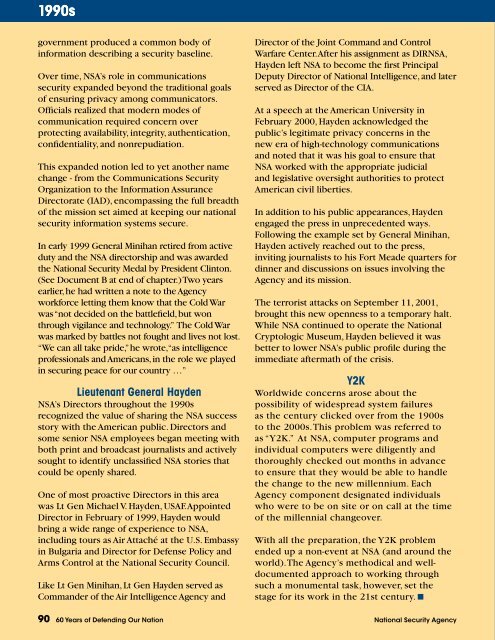National Security Agency - The Black Vault
National Security Agency - The Black Vault
National Security Agency - The Black Vault
- No tags were found...
You also want an ePaper? Increase the reach of your titles
YUMPU automatically turns print PDFs into web optimized ePapers that Google loves.
1990s<br />
1990s<br />
government produced a common body of<br />
information describing a security baseline.<br />
Over time, NSA’s role in communications<br />
security expanded beyond the traditional goals<br />
of ensuring privacy among communicators.<br />
Officials realized that modern modes of<br />
communication required concern over<br />
protecting availability, integrity, authentication,<br />
confidentiality, and nonrepudiation.<br />
This expanded notion led to yet another name<br />
change - from the Communications <strong>Security</strong><br />
Organization to the Information Assurance<br />
Directorate (IAD), encompassing the full breadth<br />
of the mission set aimed at keeping our national<br />
security information systems secure.<br />
In early 1999 General Minihan retired from active<br />
duty and the NSA directorship and was awarded<br />
the <strong>National</strong> <strong>Security</strong> Medal by President Clinton.<br />
(See Document B at end of chapter.) Two years<br />
earlier, he had written a note to the <strong>Agency</strong><br />
workforce letting them know that the Cold War<br />
was “not decided on the battlefield, but won<br />
through vigilance and technology.” <strong>The</strong> Cold War<br />
was marked by battles not fought and lives not lost.<br />
“We can all take pride,” he wrote, “as intelligence<br />
professionals and Americans, in the role we played<br />
in securing peace for our country …”<br />
Lieutenant General Hayden<br />
NSA’s Directors throughout the 1990s<br />
recognized the value of sharing the NSA success<br />
story with the American public. Directors and<br />
some senior NSA employees began meeting with<br />
both print and broadcast journalists and actively<br />
sought to identify unclassified NSA stories that<br />
could be openly shared.<br />
One of most proactive Directors in this area<br />
was Lt Gen Michael V. Hayden, USAF. Appointed<br />
Director in February of 1999, Hayden would<br />
bring a wide range of experience to NSA,<br />
including tours as Air Attaché at the U.S. Embassy<br />
in Bulgaria and Director for Defense Policy and<br />
Arms Control at the <strong>National</strong> <strong>Security</strong> Council.<br />
Like Lt Gen Minihan, Lt Gen Hayden served as<br />
Commander of the Air Intelligence <strong>Agency</strong> and<br />
Director of the Joint Command and Control<br />
Warfare Center. After his assignment as DIRNSA,<br />
Hayden left NSA to become the first Principal<br />
Deputy Director of <strong>National</strong> Intelligence, and later<br />
served as Director of the CIA.<br />
At a speech at the American University in<br />
February 2000, Hayden acknowledged the<br />
public’s legitimate privacy concerns in the<br />
new era of high-technology communications<br />
and noted that it was his goal to ensure that<br />
NSA worked with the appropriate judicial<br />
and legislative oversight authorities to protect<br />
American civil liberties.<br />
In addition to his public appearances, Hayden<br />
engaged the press in unprecedented ways.<br />
Following the example set by General Minihan,<br />
Hayden actively reached out to the press,<br />
inviting journalists to his Fort Meade quarters for<br />
dinner and discussions on issues involving the<br />
<strong>Agency</strong> and its mission.<br />
<strong>The</strong> terrorist attacks on September 11, 2001,<br />
brought this new openness to a temporary halt.<br />
While NSA continued to operate the <strong>National</strong><br />
Cryptologic Museum, Hayden believed it was<br />
better to lower NSA’s public profile during the<br />
immediate aftermath of the crisis.<br />
Y2K<br />
Worldwide concerns arose about the<br />
possibility of widespread system failures<br />
as the century clicked over from the 1900s<br />
to the 2000s. This problem was referred to<br />
as “Y2K.” At NSA, computer programs and<br />
individual computers were diligently and<br />
thoroughly checked out months in advance<br />
to ensure that they would be able to handle<br />
the change to the new millennium. Each<br />
<strong>Agency</strong> component designated individuals<br />
who were to be on site or on call at the time<br />
of the millennial changeover.<br />
With all the preparation, the Y2K problem<br />
ended up a non-event at NSA (and around the<br />
world). <strong>The</strong> <strong>Agency</strong>’s methodical and welldocumented<br />
approach to working through<br />
such a monumental task, however, set the<br />
stage for its work in the 21st century. n<br />
<strong>National</strong> <strong>Security</strong> <strong>Agency</strong><br />
Historic Documents<br />
Document A – Memorandum from Vice Admiral William O. Studeman<br />
bidding farewell to the workforce<br />
Document B – Presidential Memorandum awarding the <strong>National</strong> <strong>Security</strong><br />
Medal to Lt Gen Minihan<br />
90 60 Years of Defending Our Nation <strong>National</strong> <strong>Security</strong> <strong>Agency</strong> <strong>National</strong> <strong>Security</strong> <strong>Agency</strong> 60 Years of Defending Our Nation 91

















